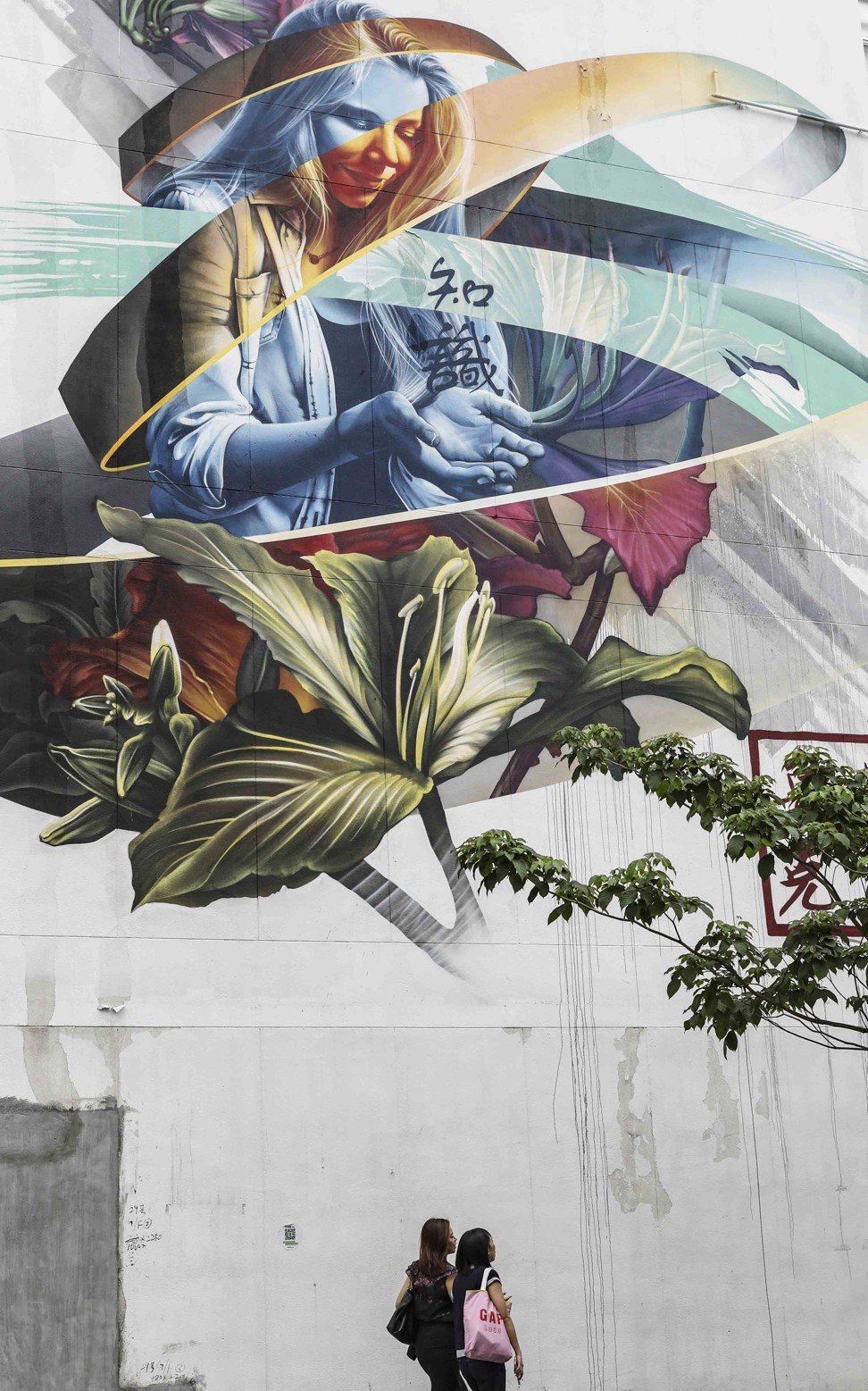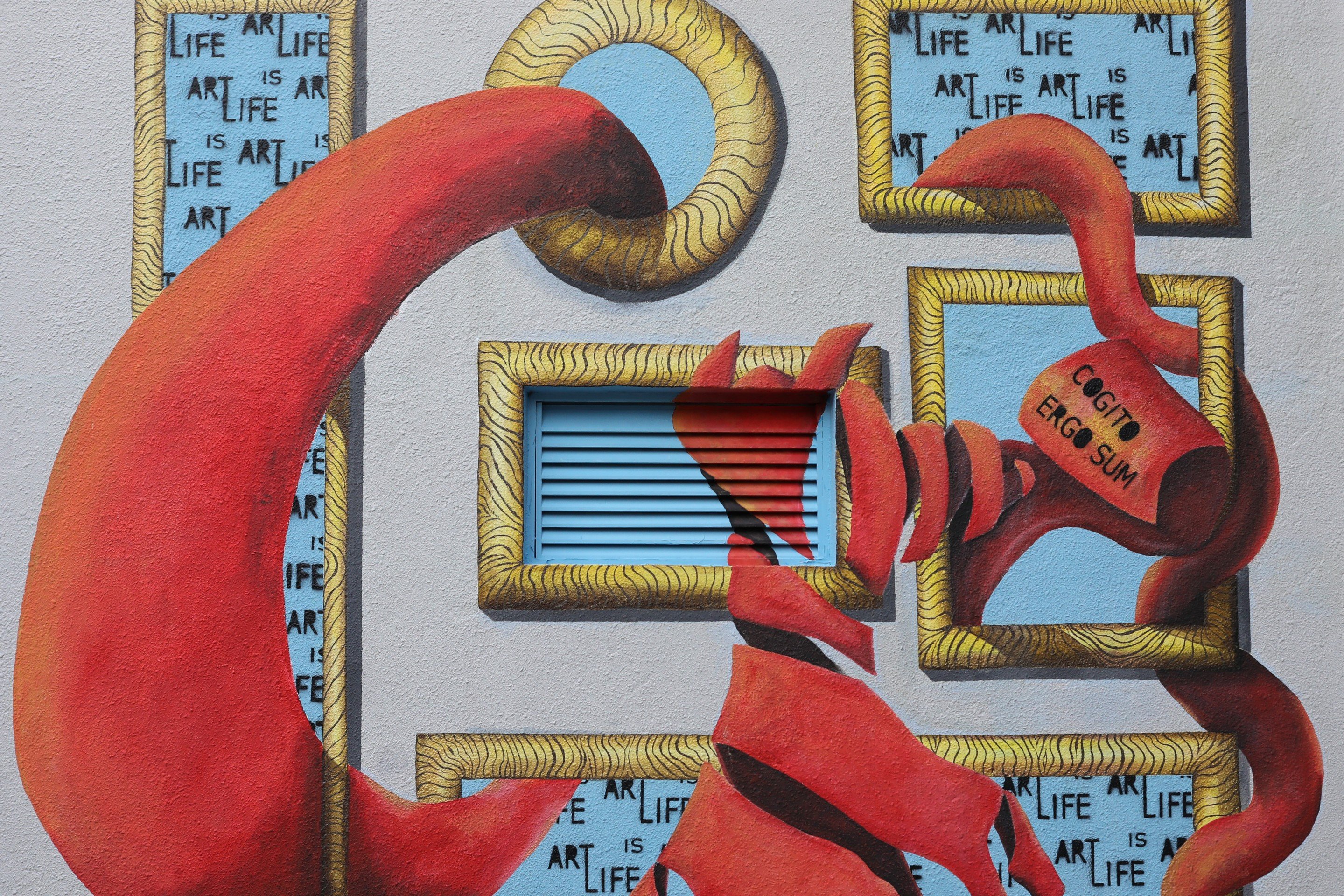
Hong Kong street art: how Wan Chai is being transformed as graffiti gains acceptance
The sixth street art festival, organised by HKwalls in collaboration with the Hong Kong Design Centre, has transformed the vibrant district into an outdoor gallery

Walls sprayed with slogans, stencils and scenes don’t just affect the aesthetic value of a city – they can also inspire cultural shifts.
Just as the original “Lennon Wall” sprang up in Prague in the 1980s, as citizens behind the iron curtain voiced their dissent through art, Hong Kong now has its own walls covered, in messages of support for the extradition bill protests. And similar to the Hong Kong streets and plazas taken over by neon Post-it notes, the Czech Lennon Wall is periodically destroyed and recreated, to symbolise uprisings – in both the creative and political spheres.
This year’s street art and mural festival organised by HKwalls did not delve into politics specifically, yet the works adorning walls in Wan Chai are redolent of a city that is becoming comfortable expressing its values through visual public media.
“[Street art] makes people more aware of the space they’re in. They stop and take notice,” says Jason Dembski, the American architect and designer who founded the non-profit HKwalls with Hongkongers Stan Wu and Maria Wong in 2014. “The Lennon Walls are about communicating thoughts and ideas and sharing them with the wider public, which is what a lot of street art is about.”

Take a stroll around Wan Chai and you’ll see an already colourful district bursting with murals ranging in size from a door to the entire side of a tower block. For the sixth year running, the area was taken over by the rattle and hiss of hundreds of spray cans, the sticky lick of rollers and the swoop and swish of brushes.
The festival is the culmination of years of work by local street artists to normalise their craft. For HKwalls, finding enough concrete canvases has been an uphill struggle as it tries to convince building owners that graffiti is not vandalism.
“For the first couple of years, people didn’t know what we were talking about and looked at us like we were crazy,” Dembski recalls. “Now people understand it and come to us with a wall they want to make available.”
Stretching from the eastern fringes of Admiralty to the western heart of Tai Hang, bisecting Hong Kong Island from the northern skyline to the southern mountain slopes, the festival has populated the 3km-wide Wan Chai district with more than 40 murals.
Wu, known for his shutter art in Stanley, and Wong, who has a background in curation and arts production, along with Dembski, scoured through the portfolios they had received over the past year before choosing a selection of artists. With approvals then secured from building owners, work started in March.
Wan Chai has a rich history, with a mix of old and new, traditional and modern
This year saw more government buildings involved, thanks to HKwalls’ partnership with the Hong Kong Design Centre (HKDC). The publicly funded body is promoting Wan Chai as a design district under its #ddHK programme.
“Wan Chai has a rich history, with a mix of old and new, traditional and modern,” says Sam Lam Mei-wah, HKDC’s director of business development. The organisation’s pairing with HKwalls is part of a plan to turn “the entire district into an open-air gallery”, to “inspire Hongkongers and visitors to discover a different Hong Kong”, she adds.
Once the artworks are finished, it is up to the building owner to protect them against the elements, but there is nothing to stop another artist making their mark on an existing image. It is, after all, street art. With Hong Kong increasingly opening up public spaces to share ideas, expect to see more blank walls transformed into forums for ideas and artistry – paint, Post-it notes, or otherwise.

One of the few designs to feature text, Hong Kong-born UUendy Lau’s line drawing also stands out for its black-and-white minimalism. Adorning an outer wall of the Vela Boutique Hotel, in Causeway Bay, the design was inspired by the nearby Wan Chai wet market, with its tanks stuffed to the gills with fish. “They were packed in a way that they looked surreal,” Lau says. “This resembles the limited living space most of us have in our city.” The artist says she hopes her piece brings a “touch of humour” through its absurdity.

Also gracing the Vela, the jewel-toned geometry of Priscilla Yu’s piece reflects the logo of the boutique hotel. Known for her vibrant patterns and perspective manipulation, the Canadian illustrator says the design, which includes a character wearing glasses in the shape of a butterfly, represents “a filter or lens where you view the world through more naturalistic means of intuition and instinct. Like a kaleidoscope that abstracts what you see, I wanted to imagine a world with a different set of natural laws”.

An artwork by Shann Larsson outside Zodiac Lighting, 32 Morrison Hill Road. The shop had requested a design related to light, so the Hong Kong-based mixed-media artist delved into Chinese folklore and chose the legend of the immortal rabbit that lives on the moon, which has become a symbol of the Mid-Autumn Festival. “The story is quite dark but it has a message of selflessness and sacrifice.” the artist says. “It’s a great story and one identifiable across generations.” And, as one of the animals of the Chinese zodiac, the rabbit is also reflected in the shop’s name.

Going Nowhere Fast, by Insa, at Tang Shiu Kin Victoria Government Secondary School, 5 Oi Kwan Road. The British artist creates works that “live both online and offline”, becoming animated when viewed through his Gif-iti app. The inspiration behind this piece was the contrast between how people identify themselves online and in the real world. “We are the first generation, we’re learning this dual identity,” Insa says. “The cycle goes on the internet and lives forever […] ultimately it’s everybody running in a circle. Everyone’s in a race, we’re all racing to nowhere.”

Mathieu’s futuristic, comic strip-style frescoes appear all over the world, serving as a breadcrumb trail for the well-travelled Colombian artist, who, between 2007 and 2011, worked on films including Transformers and Star Trek at Industrial Light and Magic, George Lucas’ visual-effects company. His work, here painted between a hospital and a school, aspires to entertain both children and the elderly with “warriors from a distant past inspired by ancient Sumerian tales” and an imagined Hong Kong “in another dimension where the banyan trees have taken over.”